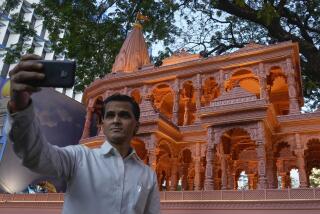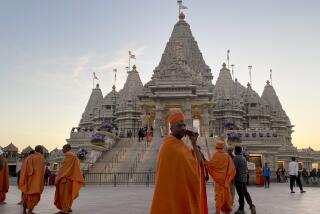Ancient Hindu blessings a mouse click away
- Share via
VARANASI, INDIA — Visitors to this ancient city are invariably struck by its timelessness, the feeling that life is as it was a thousand years ago. The faithful still bathe at dawn in the holy waters of the Ganges, the bereaved cremate their dead on hazy funeral pyres, and pilgrims trace a well-trodden circuit of temples and shrines that seem as numerous as the stars.
But India is nothing if not a land of collisions between past and present. And now the country that refined the ancient practice of Hinduism and the modern practice of outsourcing has found a way to marry the two in Varanasi. At its most venerable house of worship, dedicated to the god Shiva, outsourcing your prayers is possible with the click of a mouse.
Got an appeal for better health, or a nicer boss? Want a rich mate, or better grades for your kids? If you can’t make the pilgrimage here, an Internet connection and a small fee can book you the services of a priest at the Vishwanath Temple who will, as Indians like to say, “do the needful” for your plea to be heard on high.
“It’s a demand of this day and age,” said Radhey Shyam Pathak, who runs the temple’s daily affairs. “This was not possible even 10 years back. There are many people who wish to come here but cannot. We can help.”
The temple went online in August, and within a month received 180,000 hits on its website, shrikashivishwanath.org.
That is more than double the average number of devotees who show up in person every month, braving difficult journeys, the smelly warren of narrow alleys leading to the temple, the security pat-downs outside the entrance and the gantlet of vendors hawking sweets, garlands of marigolds and jasmine, and other religious paraphernalia.
Cyber-worshipers can be spared all of that -- and in the bargain save some time, a commodity in increasingly short supply for the growing cohort of middle-class Indians busy with the trappings of secular affluence, from attending cocktail parties to shuttling their children to after-school tutorials.
Besides outsourcing a puja, or prayers and obeisances, visitors to the Vishwanath Temple’s website can enjoy a virtual audience with the Shiva lingam, the phallus-shaped symbol that represents the deity and resides in the temple’s inner sanctum. Animated icons shower the sacred image with offerings of flowers or milk. Hymns and chants drone through the speakers.
“This is an association of religion and science -- old beliefs and new ways to follow them,” said Abhishek Drolia, one of the website’s designers.
Going high-tech is the latest twist in the history of the Vishwanath Temple, which for a thousand years has been home to one of the most important Shiva lingams in India. The city, formerly known as Benares, is the center of the Hindu universe, so holy that anyone who dies here is said to immediately achieve moksha, or liberation from the cycle of rebirth and death.
The temple has persevered despite destruction of the structure by Muslim rulers, a forced move from its original site and the ravages of modern society in the form of pollution and shoddy infrastructure.
Other well-known shrines around India also have gone into cyberspace, and officials here were keen not to be left behind, especially with millions of Hindus living on distant shores.
“It’s another way of broadcasting the message of the temple,” Pathak said. “It’s being mindful that we benefit all mankind.”
The temple’s 22 priests are “gradually adjusting” to serving digital devotees, Pathak said, adding that the prayers conducted for those who book their services online are no different from those for adherents who appear in person.
Whether the effect of the prayers is the same, on the god or the believer, depends on one’s point of view.
Shashi Menon, an electronics engineer, stumbled upon the temple’s website by accident and ordered a puja on behalf of his 5-year-old son, Sridhar. Menon, 44, lives near Mumbai, in western India; Varanasi is almost clear across the subcontinent.
“We knew we wouldn’t be able to go there in the near future,” Menon said.
He acknowledges that purists might take issue with Web-surfing worshipers like him, but that does not decrease the “psychological satisfaction” he felt in having a puja performed for his son in absentia. Ultimately, he said, “it’s all about faith.”
“If you were to look at it in a more religious context or orthodox, conservative manner, then it’s obviously not the right way to do a puja. You need to be present,” Menon said. “But in modern times, you’ve got to use modern means.”
--
More to Read
Sign up for The Wild
We’ll help you find the best places to hike, bike and run, as well as the perfect silent spots for meditation and yoga.
You may occasionally receive promotional content from the Los Angeles Times.







